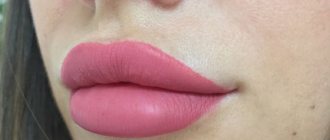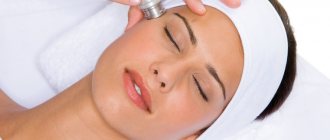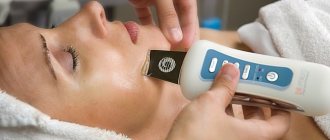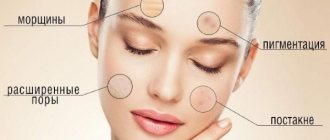One of the most common questions that a cosmetologist hears is: “After cleansing the face, how many days does the redness go away, when does the swelling go away?” Even the most qualified specialist will not be able to answer these questions unequivocally. There are a number of reasons that can aggravate the unpleasant consequences of the procedure.
Firstly, these are the characteristics of the cosmetologist’s patient’s dermis. If you are prone to acne, then the formation of pimples and inflammatory elements cannot be avoided. If the epidermis is hypersensitive, then redness may linger for more than three days.
The second reason for side effects of the procedure may be the unprofessionalism of the cosmetologist. Too much pressure during the cleansing process can cause the formation of wounds and hematomas. Insufficiently thorough cleaning of hands, skin, and tools can provoke infection and the formation of inflammation.
Possible consequences after facial cleansing and their causes
Cosmetologists warn their patients that after the procedure they may encounter some undesirable consequences. At its core, cleansing refers to a series of aggressive, even traumatic procedures. During the first 24 hours after it, the woman is likely to observe a reaction in the form of redness and slight swelling. This is considered a normal variant and does not require specific therapy.
Unpleasant consequences include the following:
- The formation of inflammatory elements or pimples. If sterility is maintained, this should not happen. The appearance of acne may indicate that the procedure caused the formation of a wound that became infected.
- Redness of the skin. Persistent redness that occurs after cleansing the face, which does not go away for more than 3 days, should alert you. Mechanical impact on the epidermis provokes a rush of blood and redness, which usually goes away after a few days.
- Formation of hematomas. This side effect indicates excess pressure when exposed to the problem area of the dermis.
- Edema. Swelling immediately after mechanical impact is considered normal. However, if after cleansing your face swelling appears and does not go away after three days, this is a reason to seek help from a specialist.
- Wounds and scars can occur if you have sensitive skin or unprofessional cleaning.
- Allergies occur when there is a hypersensitivity reaction to drugs used in cleaning.
Don't wear makeup
Why: If you know how to apply makeup on the subway or bus on the way to work, we can only congratulate you on this. On the other hand, why not use the cleansing as an excuse to show up at the office with your makeup as natural as possible. That is, no makeup at all. Let your skin breathe for 24 hours and it will thank you.
Sorry for the stupid question. But I didn’t think to ask the cosmetologist) I had a combi facial cleansing, my face was almost normal) And today I didn’t want to miss stretching at the gym, 4 hours have already passed since the cleansing session. Thank you!
One of the most popular cosmetic procedures is facial cleansing (peeling). Despite the possible pain, peeling brings great benefits to the skin, giving it freshness and attractiveness. However, after such a procedure, the dermis of the face needs special care. Read on in the article about how to properly care for your skin after cleansing your face.
How quickly does the redness go away?
During the process of mechanical facial cleansing, an intense effect on the epidermis occurs. As a result, peripheral blood circulation increases and redness occurs on the surface of the dermis. Its intensity and duration depend on the individual characteristics of the patient’s body.
A natural question that arises in the mind of every woman who sees her face after mechanical skin cleansing: how many days does the redness go away? Normally, hyperemia of the epidermis should last no more than three days. If after this period the redness does not go away, then you should definitely consult a doctor. He will select individual therapy. Often, when redness occurs, it is recommended to use ointment with dexpanthenol, as well as make compresses with chamomile or aloe Vera juice.
What not to do after cleaning?
Actions that negatively affect the condition of the face after a cleansing procedure:
- Visiting a sauna or steam bath. Under the influence of high temperatures, the face steams and moisture is lost. After a fresh procedure, open pores and hot air are a direct path to infection. It is recommended to refrain from visiting the steam room for at least 2-3 weeks.
- Face massage. Intense massaging movements further damage the skin, which causes even more stress for the body. Massage can be performed no earlier than 2 weeks after cleaning.
- Washing is postponed until the next day. During this period, the skin is vulnerable to any influences, especially to hard running water. There is a risk of introducing contamination.
- It is forbidden to sunbathe for 3-4 weeks after intensive cleaning. Many cosmetic cleansing procedures are performed using harsh peeling. As a result, the skin is severely damaged and takes some time to heal. Exposure to direct sunlight on damaged skin increases the risk of developing cancer.
- You should not squeeze out pimples after a cosmetologist’s work. If the specialist left a few pieces, then they really shouldn’t be touched. After a fresh procedure, the risk of infection increases many times over by squeezing out acne. Moreover, the skin is even more damaged.
- In the first 2 days it is better not to use decorative cosmetics. It clogs pores and worsens the result of the work done.
Following the recommendations will protect the skin from infection and negative consequences.
Which rashes after brushing are considered normal and which are not?
Experienced cosmetologists say: the formation of small superficial pimples after mechanical cleansing is natural and does not pose any danger. Thus, the epidermis gets rid of accumulated impurities and toxins. After vacuum or chemical cleaning, a layer of keratinized scales is removed from the epidermis and inflammation becomes more noticeable, pimples form faster.
In some cases, rashes on the face after cleansing are dangerous:
- the appearance of brightly colored red areas on the skin, similar to a rash, can be the result of a chemical burn;
- small pustules and itching of the skin are a sign of an allergic reaction to products used to treat the face or instrument, or to sunscreen;
- subcutaneous acne can be caused by the use of an excessively greasy product during mechanical cleansing, which is not suitable for the patient’s skin type.
Attention! Squeezing pimples and blackheads is strictly not recommended. There is a high risk of serious complications.
If the above warning signs are detected, you should stop self-medicating and consult a qualified dermatologist.
How to get rid of or avoid consequences - advice from cosmetologists
As we have already said, the skin after cleansing the face becomes very vulnerable, because it has lost the upper stratum corneum. Although it is a kind of “ballast”, it at the same time protects the surface from external aggressive influences.
Let's consider the recommendations of cosmetologists regarding each undesirable manifestation after facial cleansing:
- when pimples appear, it is necessary to lubricate each of them with an antiseptic (iodine, chlorhexidine);
- redness, as a rule, goes away on its own in the salon. After all, the master applies a special soothing mask. To speed up the process, you can use aloe vera gel;
- spots require investigation. If they occur as a result of vascular injury, you need to very carefully massage the area, after applying aloe. Be sure to use a moisturizer according to your skin type;
- Apply iodine to wounds and inflamed areas and make a clay mask based on mineral water. Before going outside, treat all problem areas with an antiseptic lotion for oily skin and apply salicylic ointment;
- when peeling, use aloe gel, super moisturizing cream according to your skin type, moisturizing, nourishing masks for facial care;
- Panthenol cream, the same gel with aloe, can cope with burns;
- Bruises and bruises appear quite rarely. In this case, it is better to contact a specialist who will select an individual remedy to eliminate the side effect.
But do not forget that after cleansing your skin requires careful, careful, specific care, not only in case of unwanted manifestations. There is a whole list of prohibitions and necessary manipulations that will help a quick recovery.
Proper care after the procedure
The success of facial cleansing largely depends on how a woman follows skin care recommendations. Often cosmetologists supplement Metrogyl cleansing with gel and this gives a good effect. However, the use of antibiotics is not always justified or appropriate. Then cosmetologists advise the following actions:
- Wash your face with melt water or mineral water. You can also add lemon juice and apple cider vinegar to the solution. In this way, the surface of the epidermis is acidified and many problems with inflammation are solved.
- During the rehabilitation period, pamper your skin with fortified cocktail compositions for facial skin.
During the process of cleansing the face and in the subsequent rehabilitation period, compliance with these rules will minimize or avoid the formation of inflammatory elements:
- meticulously maintain cleanliness of skin, hands and tools;
- choose your favorite skin care products that suit your skin type;
- do not abuse cosmetic products with comedogenic effects;
- reduce your time in the sun;
- adjust your diet by eliminating junk food and enriching it with vegetables and fruits.
Skin care after cleansing
Facial care after 55 years at home
The first time after the procedure, the skin becomes more sensitive and receptive to external irritants. This is due to the fact that as a result of cleansing, the stratum corneum of the dermis is removed, which to a certain extent protected the skin from the effects of negative factors. To cleanse your face without complications, it is recommended to follow a number of simple rules for facial care:
- On the first day after cleansing, you should not touch the skin, exert mechanical force on it, or expose it to chemicals.
- The use of alcohol-containing products is not allowed, as they dry out the skin. An exception is the treatment of scratches and other damaged areas.
- It is recommended to regularly rinse your face with decoctions of chamomile, calendula, plantain, etc.
- For the first few days, wash your face with water and a small amount of vinegar or lemon juice. Melt or mineral water is best.
- The skin needs to be moisturized regularly. To do this, apply moisturizer to the face up to 2 times a day.
- It is advisable to make masks 2-3 times a week to nourish and soothe the skin. Recommended ingredients: honey, fruit pulp, chicken yolk.
- Wipe your face with chlorhexidine or hydrogen peroxide for 2-3 days.
Homemade face masks should be used no more than once every 2-3 days. Here are examples of a few of them:
- Bodyagi mask.
- A mask based on egg whites with the addition of lemon juice.
- Anti-inflammatory blue clay mask.
- Sour cream mask.
- Coffee grounds mask.
- Nourishing mask made from yogurt with added yeast.
Mask after cleansing the face
Depending on the cleaning method, there are separate rules for facial care.
The manual method of cleansing is effective, but at the same time it is quite traumatic (scars may remain after the procedure). To protect yourself from unpleasant consequences, it is better to contact an experienced cosmetologist.
Care after mechanical (manual) facial cleansing involves the following:
- Since the integrity of the skin is compromised, there is a risk of infection. Therefore, touching your face should only be done in extreme cases.
- You can eliminate swelling and redness with compresses and ice cubes.
- To quickly heal damaged areas, it is recommended to treat the skin with aloe juice.
- Clay masks will help reduce sebum production and speed up the process of restoration of the dermis.
Proper care after cleansing the face promotes faster tissue regeneration - after 5-7 days the skin will be completely restored.
Cleaning with ultrasound is the safest, painless and least traumatic way to cleanse the skin.
Before the procedure, there is no need to steam the dermis, which saves time and reduces the risk of infection in the tissue. During the cleansing process, the skin is not stretched or compressed.
After ultrasonic cleaning, you should care for your skin as follows:
- Avoid washing your face for 24 hours after the procedure.
- On the second day and during the recovery period, use purified water instead of regular water, use cleansers that do not contain alcohol and have a neutral acid-base balance.
- Eliminate oily skin with toner.
- Make masks 2-3 times a week to relieve swelling and inflammation. You can use honey, oatmeal, clay, and raw potatoes as ingredients.
- The last point is to use sunscreen.
Important! To exclude complications, you should consult a dermatologist and cosmetologist before the ultrasound procedure.
Vacuum cleaning involves the use of a special device in the form of a drainage pipe, which creates a vacuum effect. The pipe is applied to the face, through it the impurities accumulated in the tissues are drawn out. The procedure takes about half an hour. This method is painless. The vacuum effect improves metabolism in dermal cells and stimulates microcirculation. However, unlike a manual procedure, this type of cleansing does not eliminate comedones and milia.
Special care will help speed up the recovery period after vacuum cleansing:
- Nourish and moisturize the skin through creams and masks.
- Use of sunscreens.
- For the first two days after the procedure, avoid peeling and scrubbing.
- It is not advisable to visit a sauna, bathhouse, or solarium.
Laser cleansing is an effective and painless way to cleanse the skin. In addition to dirt and fat accumulations, the procedure helps get rid of pigmentation, comedones, acne, and also promotes facial rejuvenation by smoothing out small wrinkles.
4-5 days – that’s how long the rehabilitation period after laser therapy is. For the first few days, you must follow the following recommendations:
- Limit exposure to external irritants (sunlight, wind, extreme cold) on the skin.
- Avoid visiting bathhouses, saunas, and solariums.
- Moisturize the skin with special creams and masks.
As for care in a beauty salon, after cleaning your face you can undergo a number of the following procedures:
- Darsonval. The device is a glass tube that, under the influence of current, treats the skin without affecting the surface of the face. The method promotes rapid resorption of the tubercles. The procedure is painless, except for a slight tingling sensation.
Darsonvalization of the face
- Cryomassage. The method involves treating the dermis with liquid nitrogen.
After such procedures, it is better not to go outside for an hour. During this time, the redness will decrease and the burning sensation will go away. It is advisable to carry out these procedures several times.
Facial cryotherapy with liquid nitrogen
What is not recommended?
At the moment when the face begins to heal after cleansing, a woman should limit herself to a number of procedures. This is a list of actions that absolutely cannot be performed after cleaning:
- for 2-3 days, minimize exposure to the street, do not wash your face, and avoid any exposure to the skin;
- for a week refuse to visit the bathhouse, sauna, swimming pool;
- do not wash your face with hot water or chlorinated tap water;
- do not drink alcoholic beverages;
- do not exfoliate the skin using scrubs;
- do not injure the skin mechanically;
- do not use creams with natural ingredients to avoid an allergic reaction;
- do not wash your face with soap, which dries out the epidermis and leads to the formation of cracks;
- Do not overload your skin with cosmetic products.
How to speed up healing
Redness and minor superficial pimples are a normal reaction of the body to cleansing the skin. After the layer of keratinized cells is eliminated, an inflammatory process develops, causing hyperemia.
However, bright red areas may indicate the presence of a chemical burn; itching of the epidermis and ulcers indicate an allergic reaction. If acne appears, the specialist used an excessively greasy product during cleaning.
If the above manifestations occur, you should urgently visit a doctor. Squeezing out rashes is strictly prohibited. Proper skin care will significantly reduce the recovery period.
To eliminate inflammation, you need to wash your face with mineral or melt water. During rehabilitation, you can treat the skin with vitamin cocktails. It’s better not to go outside again, and be sure to apply sunscreen before going out.
Particular attention must be paid to nutrition. The basis of the diet should be fresh vegetables and fruits.
During the recovery period, the skin heals, so it is important to follow a number of rules. For three days, you should not touch the epidermis with your hands, wash your face with hot or untreated tap water, or go outside often. Visits to the swimming pool, bathhouse, solarium, and sauna are prohibited for a week.
In addition, you should not drink alcohol, use scrubs, cosmetics, or creams. Soap dries out the skin, which causes cracks.
On this topic
- Face cleaning
How often should you cleanse your face?
- Olga Aleksandrovna Kalinina
- October 18, 2020
To speed up healing, electrical stimulation of the skin and cryomassage are performed. Various soothing face masks are no less beneficial for the epidermis.
Skin cleansing is an effective procedure, after which side effects often occur. To minimize the risk of complications, it is important to have the manipulation done by an experienced specialist, and after the session strictly follow all medical instructions.
What is possible?
In order to minimize the negative consequences of mechanical facial cleansing, you can use gentle cosmetic procedures:
- Darsonval - electrical stimulation of the epidermis, improving regenerative processes. It is completely safe, does not cause discomfort and effectively helps eliminate redness, swelling and inflammation.
- Cryomassage is the effect of liquid nitrogen on the epidermis. The effect is noticeable after the first procedure: the skin calms down, the discomfort goes away.
- The use of homemade masks based on herbs: chamomile, plantain, celandine and calendula. Good ingredients include cucumbers, clay, egg, lemon, bodyaga, coffee grounds, kefir, and yeast.
Procedure
Caring for oily skin in adolescence
With the exception of some differences in the cosmetics used and the number of stages, mechanical cleaning in the salon is approximately the same.
Stage 1. Cleansing and preparation
After removing makeup and cleansing the skin with a cleanser, a solution is applied to the face to soften the pores and have an analgesic effect. They put a film on it and wait the allotted time.
Stage 2 Disinfection and cleaning
After removing the preparatory gel, the skin is sprayed with chlorhexidine or another disinfectant. In order not to “tighten” the sebaceous duct, the cosmetologist should not use alcohol. Next comes cleaning.
Using tools, a specialist wearing gloves and hair removed works on the skin. You may feel slight pain or discomfort, and this is normal. Clots of sebum are removed from the pores, without in any way affecting the inflamed elements.
Stage 3. Consolidate the result
After cleaning the pores, the face is again treated with an antiseptic. Next, you may be given liquid nitrogen or a clay mask to soothe the irritated epidermis. Finally, you will be treated with a nourishing, healing cream. At home, you can use pharmaceutical creams with a similar effect (for example, Panthenol).
Don't expect an immediate effect - all the beauty of skin cleansing in the salon will be noticeable after the redness subsides.
If you have too many sebaceous plugs, then it is better to undergo cleansing in several procedures - this will reduce the risk of skin inflammation. After mechanical cleaning, people may experience irritation for 1-2 days - and this is considered normal. However, if you have persistent bruises, bruises or deep wounds, then the beautician most likely treated your face too roughly.
Mechanical cleaning is not recommended for people with constantly clogged pores more than once a month. No more than once a year for those who have mild pollution or appear extremely rarely.
Tips to avoid side effects
Before answering the question of how many days redness lasts after mechanical facial cleansing, the cosmetologist gives a number of recommendations to the patient. The negative consequences of the procedure can be easily avoided if:
- carry out the procedure in a cosmetologist’s office, which is equipped with special equipment and materials to ensure sterility;
- trust only a qualified technician;
- strictly follow all recommendations of a doctor or cosmetologist for skin care during the rehabilitation period.
All these tips will help you avoid facial redness after cleansing. The result of the procedure will be only radiant clean skin.
For a variety of facial skin cleansing methods, watch the video:
Advice from experienced doctors and cosmetologists
Experts note that after cleansing the face, especially as a result of manual therapy, side effects may occur. These include:
- Red spots. The reason is dehydration of the dermis or damage to the vessel.
- Redness. It goes away on its own after a few hours.
- Swelling. The appearance of mild swelling the day after the procedure is normal.
- Pimples. May occur as a result of infection. They may also appear if contraindications are ignored (dermatitis, asthma, menstrual cycle).
- Bruises. This is a consequence of intense mechanical impact on the skin during manual or vacuum cleaning. Bruising may also occur as a result of the injury.
- Allergy. It appears against the background of hypersensitivity to the drugs used in cleaning processes.
- Burns. They can form due to individual intolerance to the components included in cleansing products (for example, Comodex). Another common cause is improperly performed laser or ultrasonic skin cleansing.
On a note. Most of the side effects go away on their own 2-3 days after cleansing the face. Light burns and damage can be eliminated with panthenol ointment.
You should consult a doctor in the following cases:
- A chemical burn that appears in patches of bright red color.
- Severe swelling.
- Small purulent rashes and itching. The reason is an allergy to sunscreen or intolerance to cleansing preparations.
- Acne. They may appear as a result of using too oily skin cleansers (especially if the skin was originally of oily or combination type).
The following recommendations after cleansing your face will help to minimize side effects and avoid complications:
- You need to choose only an experienced, well-proven specialist. Get the information you need from reviews of other customers.
- The office must have all the necessary materials and equipment to ensure the sterility of the procedure.
Cleaning materials must be sterile
- If the salon’s services are priced below market value, it is better to refuse them.
- The procedure cannot be performed if there are contraindications:
- Asthma.
- Hypersensitivity of the dermis.
- Skin diseases in the acute stage.
- Diabetes.
- Cuperosis.
- Menstrual cycle.
- Pregnancy and breastfeeding period.
- High blood pressure.
- The presence of lesions and papillomas on the skin.
- Decreased skin tone.
If at least one of the listed signs is present, the procedure can only be authorized by a specialist.
In order for the skin to remain healthy and beautiful for many years, it is very important not only to cleanse it correctly, but also to follow all the necessary conditions and recommendations for facial care after cleansing.
For whom is facial cleansing contraindicated?
Mechanical cleansing is one of the simplest methods of affecting the skin and does not require specific equipment. However, there are a number of contraindications to this procedure:
- skin diseases in the acute stage;
- increased sensitivity and dryness of the epidermis;
- menstruation;
- circulatory diseases;
- asthma;
- arterial hypertension;
- the presence of papillomas, moles;
- rosacea;
- tendency to develop acne.
If at least one of these signs is present, it is better to refuse mechanical cleansing of the face.
Do I need to prepare my face for cleansing?
No special preparation is required for facial cleansing. You do not need to do anything at home before performing this procedure. A woman should not steam her skin or remove decorative cosmetics. All these actions are carried out by a master in a clinic or beauty salon.
In the salon, preparation for facial cleansing consists of several stages:
- Carrying out thorough disinfection of instruments. A specialist must treat all metal devices with an antiseptic solution;
- Performing makeup removal and cleansing. During this procedure, the cosmetologist applies a special mask or lotion to the face, this will ensure complete dissolution of residues from decorative cosmetics, sebum, and dirt;
- Softening of the stratum corneum. The specialist expands the pores for easy and effective cleaning. This procedure is carried out using hot steam, water manipulations, special masks, and warming gels.
Mechanical facial cleansing at home
Warming gel for facial cleansing in Russia
Wash your face with soap or other cleansers. Then, clean your face with a scrub. You can make the scrub yourself, or you can use a ready-made one.
Recipes for making scrubs.
1. Take a spoonful of yogurt or sour cream and add freshly ground coffee.
2. Take a spoonful of crushed flakes and mix with cream or milk.
3. Take a spoonful of honey, add cinnamon or crushed flakes and grape oil.
You need to massage your face with the scrub for about 3 minutes. The scrub should not contain large particles, as it may damage the skin. When using a scrub, do not press too hard on the skin, this can also lead to damage.
After the scrub, steam your face. You can steam your face over a bowl of boiling water or in a bathhouse.
After this, proceed to cleansing your face. Treat your face with some alcohol-free antiseptic. This could be hydrogen peroxide or chlorhexidine. Hands should be treated with alcohol.
To squeeze out a blackhead, you need to press on it from both sides with your index fingers. Press gently; if the blackhead does not come out, leave it. Try squeezing it out after steaming your face again. Do not press the points with your nails. Because of them, marks may remain on the skin. During cleaning, it is necessary to treat the skin with an antiseptic.
After completing the procedure, treat the skin with alcohol or an alcohol-containing tonic. Then apply moisturizer.
This facial cleansing is best done in the evening before a day off. The skin should rest for at least a day without makeup. After manual cleansing, your face may turn red, but this is not a big deal. The redness will subside in 20–30 hours.
The procedure can be repeated after a few days, but you should not do it constantly. This is a real test for facial skin, so this procedure should be carried out no more than once a month.
Mechanical facial cleansing allows you to clean deep pores and old comedones. At home there is a danger of infection, so be careful and follow all the rules of asepsis. Use only sterile instruments.
If you suspect an infection, consult a doctor.
Author of the article: Golikova Natalya










